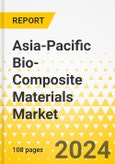This report comes with 10% free customization, enabling you to add data that meets your specific business needs.
The Asia-Pacific bio-composite materials market (excluding China) was valued at $4.16 billion in 2023, and it is expected to grow at a CAGR of 17.83% and reach $18.23 billion by 2032. The Asia-Pacific bio-composite materials market is expected to grow due to a number of factors, the most important of which is rising awareness and adoption of eco-friendly and biodegradable materials in a variety of industries, including automotive, construction, packaging, and consumer goods, among others.
Market Introduction
The Asia-Pacific bio-composite materials market is in a growing phase, with a rapid increase in the number of companies offering bio-composite materials. Recent technological advancements in bio-composite materials, such as natural fibers and wood fibers, as well as an increasing number of construction projects, the automotive industry, renewable energy demand, and the electronics and consumer goods sectors, are driving the global adoption of bio-composite materials. Furthermore, due to the increasing demand for environmentally friendly and sustainable materials, many industry players are looking forward to the future of the bio-composite materials market. The increased global investment in eco-friendly materials is being driven primarily by their low environmental impact and cost-effectiveness. Furthermore, bio-composite materials have the potential to outperform traditional alternatives in terms of sustainability and performance.
Market Segmentation:
Segmentation 1: by Application
- Automotive
- Construction
- Aerospace
- Consumer Goods
- Packaging
- Electronics
- Renewable Energy
- Others
Segmentation 2: by Material Type
- Natural Fibers
- Wood Fibers
- Bio-Polymers
- Next-Generation Materials
- Recycled Materials
- Synthetic Polymers
- Others
Segmentation 3: by Product Type
- Green Composites
- Hybrid Composites
Segmentation 4: by Processing Technique
- Compression Molding
- Injection Molding
- Resin Transfer Molding
- Extrusion
- Others
Segmentation 5: by Country
- Japan
- South Korea
- India
- Rest-of-Asia-Pacific and Japan
How can this report add value to an organization?
Product/Innovation Strategy: The product segment helps the reader to understand the different types involved in the Asia-Pacific bio-composite materials market. Moreover, the study provides the reader with a detailed understanding of the Asia-Pacific bio-composite materials market based on the application (automotive, construction, aerospace, consumer goods, packaging, electronics, renewable energy, and others). The bio-composite materials market is gaining traction in applications on the back of sustainability concerns and their higher tensile strength and toughness, among others. Bio-composite materials are also being used for controlling greenhouse gas (GHG) emissions. Moreover, partnerships and collaborations are expected to play a crucial role in strengthening market position over the coming years, with the companies focusing on bolstering their technological capabilities and gaining a dominant market share in the bio-composite materials industry.
Growth/Marketing Strategy: The Asia-Pacific bio-composite materials market has been growing at a rapid pace. The market offers enormous opportunities for existing and emerging market players. Some of the strategies covered in this segment are mergers and acquisitions, product launches, partnerships and collaborations, business expansions, and investments. The strategies preferred by companies to maintain and strengthen their market position primarily include partnerships, agreements, and collaborations.
Competitive Strategy: The key players in the Asia-Pacific bio-composite materials market analyzed and profiled in the study include bio-composite materials suppliers that develop, maintain, and market bio-composite materials. Moreover, a detailed competitive benchmarking of the players operating in the bio-composite materials market has been done to help the reader understand the ways in which players stack against each other, presenting a clear market landscape. Additionally, comprehensive competitive strategies such as partnerships, agreements, and collaborations will aid the reader in understanding the untapped revenue pockets in the market.
This product will be delivered within 3-5 business days.
Table of Contents
Companies Mentioned
- Anhui Guofeng Wood-Plastic Composite Co., Ltd
- Nanjing Xuhua Sundi New Building Materials Co., Ltd
Table Information
| Report Attribute | Details |
|---|---|
| No. of Pages | 108 |
| Published | January 2024 |
| Forecast Period | 2023 - 2032 |
| Estimated Market Value ( USD | $ 4.16 Billion |
| Forecasted Market Value ( USD | $ 18.23 Billion |
| Compound Annual Growth Rate | 17.8% |
| Regions Covered | Asia Pacific |
| No. of Companies Mentioned | 2 |









